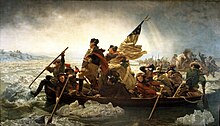Prince Whipple
This article includes a list of general references, but it lacks sufficient corresponding inline citations. (August 2016) |
Prince Whipple (1750–1796) was an African American slave and later freedman who accompanied his former owner, General William Whipple of the New Hampshire militia, during the American Revolutionary War.[1][2][3]
Early life
In his 1855 book Colored Patriots of the American Revolution, the nineteenth-century African-American author and abolitionist William Cooper Nell related some undocumented anecdotes about Whipple and his life:
Prince Whipple was born in Ambou [sic], in Ghana, of comparatively wealthy parents. When about ten years of age, he was sent by them, in company with a cousin, to America to be educated. An elder brother had returned four years before, and his parents were anxious that their child should receive the same benefits. The captain who brought the two boys over proved to be a treacherous villain, and carried them to Baltimore, where he exposed them for sale, they were both purchased by Portsmouth, New Hampshire men, Prince falling to General William Whipple. He was emancipated during the [Revolutionary] War, was much esteemed, and was once entrusted by the General with a large sum of money to carry from Salem to Portsmouth. He was attacked on the road, near Newburyport, by two ruffians; one was struck with a loaded whip, the other one he shot ... Prince was beloved by all who knew him. He was also known as "Caleb Quotom" of Portsmouth, where he died leaving a widow, Dinah, a freeperson and two children.
According to the Portsmouth, New Hampshire Town Records,[4] General Whipple granted Prince Whipple the rights of a freeman on February 22, 1781, Prince's wedding day. He was legally manumitted by Gen. William Whipple on February 26, 1784.
Legacy

According to legend, Prince Whipple accompanied General Whipple and George Washington in the famous crossing of the Delaware River[5] and is the black man portrayed fending off ice with an oar at Washington's knee in the painting Washington Crossing the Delaware, painted 75 years after the event by German American artist Emanuel Leutze. Most historians doubt that there is any basis for this story. It is extremely unlikely that either General Whipple or Prince Whipple was present at the Battle of Trenton. At that time, General Whipple was serving in the Continental Congress, which had fled Philadelphia and reconvened in Baltimore, a distance of 135 miles (217 km) from Trenton. Moreover, Prince Whipple was not famous at the time the painting was commissioned, and it is unlikely that Leutze would have heard of him. However, his story of fighting to gain freedom was related as early as 1829 by C.A.Goodrich in his book (pg 141) Lives of the Signers to The Declaration of Independence.
Notes
- ^ "This Was a Man". 18 January 2003. Archived from the original on 18 January 2003.
{{cite web}}: CS1 maint: bot: original URL status unknown (link) - ^ "Prince Whipple: Symbol of African Americans at the Battle of Trenton". 18 August 2002. Archived from the original on 18 August 2002.
{{cite web}}: CS1 maint: bot: original URL status unknown (link) - ^ "Moffatt-Ladd House & Garden". 27 July 2011. Archived from the original on 27 July 2011.
{{cite web}}: CS1 maint: bot: original URL status unknown (link) - ^ Portsmouth Town Records, Vol. III, p. 95, New Hampshire State Library at Concord, New Hampshire
- ^ https://web.archive.org/web/20020818053717/http://whipple.org/prince/princewhipple.html
References
- Robinson, J. Dennis. "Prince Whipple and American Painting", from SeacoastNH.com.
- Afro-American History thru Art page
- Lives of the Signers to the Declaration of Independence. By Rev. Charles A. goodrich, published by William Reed & Co. New York 1829
